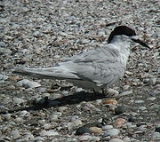
White-fronted Tern
Encyclopedia
The White-fronted Tern is the most common tern
of New Zealand
. It rarely swims, apart from bathing, despite having webbed feet. The species is protected.
White-fronted Terns feed in large flocks
by plunge diving on shoals of smelt and pilchards which have been driven to the surface by larger fish and are easily caught. Like all terns they fly with their head
s and bill
s pointing down to see their prey.
Breeding is between October and January in large colonies on rocky cliffs and offshore islands.
Tern
Terns are seabirds in the family Sternidae, previously considered a subfamily of the gull family Laridae . They form a lineage with the gulls and skimmers which in turn is related to skuas and auks...
of New Zealand
New Zealand
New Zealand is an island country in the south-western Pacific Ocean comprising two main landmasses and numerous smaller islands. The country is situated some east of Australia across the Tasman Sea, and roughly south of the Pacific island nations of New Caledonia, Fiji, and Tonga...
. It rarely swims, apart from bathing, despite having webbed feet. The species is protected.
White-fronted Terns feed in large flocks
Flock (birds)
A flock is a group of birds conducting flocking behavior in flight, or while foraging. The term is akin to the herd amongst mammals. The benefits of aggregating in flocks are varied and flocks will form explicitly for specific purposes...
by plunge diving on shoals of smelt and pilchards which have been driven to the surface by larger fish and are easily caught. Like all terns they fly with their head
Head
In anatomy, the head of an animal is the rostral part that usually comprises the brain, eyes, ears, nose and mouth . Some very simple animals may not have a head, but many bilaterally symmetric forms do....
s and bill
Beak
The beak, bill or rostrum is an external anatomical structure of birds which is used for eating and for grooming, manipulating objects, killing prey, fighting, probing for food, courtship and feeding young...
s pointing down to see their prey.
Breeding is between October and January in large colonies on rocky cliffs and offshore islands.

